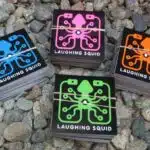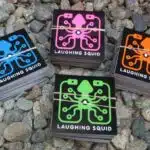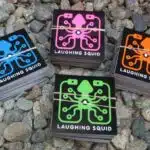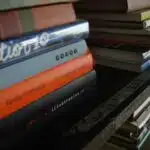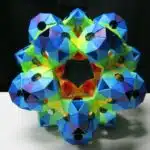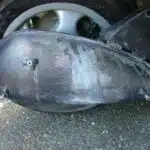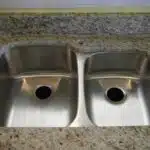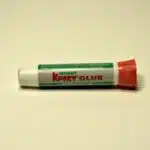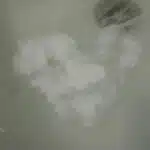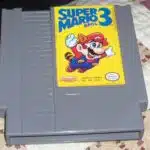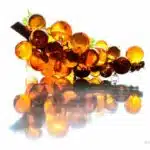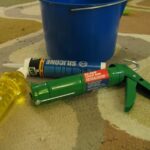Stickers are a popular way to adorn personal items, household goods, and gifts. However, removing the sticky residue left behind can be a tedious task that requires time and effort. When it comes to plastic surfaces, getting rid of sticker residue can be particularly challenging as it tends to cling onto smooth surfaces. In this article, we will explore different methods for removing sticker residue from plastic surfaces effectively.
As professional cleaners, we understand how frustrating it can be to have stickers or adhesive residues stuck on your favorite plastic items. Whether it is a stubborn price tag on new merchandise or an old label that needs to come off before recycling the container, there are several techniques you can use to remove the residue without damaging the surface. With our helpful tips and tricks, you’ll be able to clean up your plastic items quickly and easily without leaving any unsightly marks. So let’s dive in and discover how to get sticker residue off plastic!
Understanding The Nature Of Sticker Residue
Imagine taking a sticker off a plastic surface, only to find that its residue remains. This sticky substance can be problematic, especially if you’re trying to keep your plastic items clean and looking new. Understanding residue composition is crucial in figuring out how to effectively remove it from the plastic surface.
Sticker residue is typically made up of adhesive substances and other components that vary based on the type of sticker used. These adhesives can be synthetic or natural, and they may contain various chemicals that impact their stickiness level. Additionally, these adhesives may have different solubility levels, depending on the type of solvent used.
The impact of residue on plastic surface longevity can be significant as well. Oftentimes, the leftover adhesive can attract dirt and grime, making it difficult to clean the item thoroughly. If left unattended for an extended period, this residue buildup could even cause discoloration or damage to the plastic surface. Understanding how to remove this sticky substance effectively requires proper assessment of the type of plastic surface in question.
Assessing The Type Of Plastic Surface
- Identifying the type of plastic surface is essential for assessing how to properly remove sticker residue.
- Cleaning plastic surfaces requires the use of specific cleaning agents depending on the type of plastic.
- Testing the adhesive strength of the sticker residue is necessary to determine the appropriate cleaning method.
- Different types of plastic surfaces require different cleaning techniques, so the plastic type must be identified first.
- Solvents and cleaning agents can be used to safely remove sticker residue from plastic surfaces.
- Care should be taken to ensure the cleaning agent used does not damage the plastic surface or cause discoloration.
Identifying Plastic Type
Identifying the type of plastic is crucial in effectively removing sticker residue from a plastic surface. You can’t use just any cleaning solution as certain types of plastics may react to some chemicals, causing damage or discoloration. Therefore, it’s essential to identify the plastic type before attempting to remove the sticky residue.
To determine the type of plastic, start by checking for any identification codes or symbols on the surface. Many plastics come with markings that indicate their specific type and properties. These codes are usually molded into the material or printed on a label attached to the product. A careful review of these markings will help you identify whether the plastic is polypropylene, polyethylene terephthalate (PET), polycarbonate, or another type.
If there are no identification codes or symbols present, you can perform a surface evaluation test by exposing a small area of the plastic to different solvents and observing its reaction. For instance, rubbing alcohol works well on most plastics but may not be suitable for all types. Acetone should be avoided for softer plastics like PVC and thermoplastic elastomers as it can cause them to dissolve. By conducting this test on an inconspicuous spot, you can determine what solution works best before applying it more broadly.
In summary, identifying the type of plastic using either identification codes or performing a surface evaluation test is vital when removing sticker residue from a plastic surface. This process ensures that you choose an appropriate cleaning solution that won’t damage your plastic item while effectively getting rid of any stubborn adhesive residue remaining after peeling off stickers or labels from your items.
Cleaning Plastic Surface
Understanding adhesive chemistry is essential in effectively cleaning plastic surfaces. Sticker residue buildup can be challenging to remove, especially if left unattended for an extended period. However, using the right cleaning solutions and techniques can help make the process easier.
When it comes to cleaning plastic surfaces, it’s essential to consider the type of plastic before using any chemical or cleaning solution. Some plastics are more delicate than others and may react negatively to some chemicals, causing discoloration, warping, or even melting. Therefore, identifying the type of plastic is crucial in choosing the appropriate cleaning solution and technique.
Preventing sticker residue buildup on plastic surfaces requires regular maintenance and care. Using a soft cloth or sponge with mild soap and water can help remove surface dirt and dust that may attract stickers or labels. Also, avoiding placing stickers or labels on areas prone to heat or moisture can help prevent adhesive build-up over time. By following these preventive measures and understanding adhesive chemistry, you can keep your plastic surfaces clean and free from stubborn sticker residues.
Testing Sticker Adhesive Strength
In assessing the type of plastic surface, testing sticker adhesive strength is another critical factor to consider. This process involves testing the adhesive properties of a sticker or label on a small, inconspicuous area of the plastic surface before applying it in large quantities. This way, you can determine whether the adhesive used will cause damage or discoloration to the plastic.
There are various testing methods for sticker adhesive strength, including the tape test and solvent wipe test. The tape test involves placing a piece of clear tape over a portion of the sticker or label and then removing it quickly. If there is any residue left behind, it indicates that the adhesive is likely to build up over time and cause difficulty in removal. On the other hand, the solvent wipe test involves using solvents like rubbing alcohol or nail polish remover to wipe over a small area where you intend to place the sticker or label. If there is any discoloration or melting of the plastic, it’s advisable not to use that particular adhesive.
Testing sticker adhesive strength may seem like an unnecessary step, but it’s crucial in ensuring that your plastic surfaces remain undamaged and free from stubborn residue buildup. By understanding these testing methods and incorporating them into your cleaning routine, you can ensure that your efforts are effective and safe for your plastic surfaces’ longevity.
Preparing The Necessary Materials
Choosing appropriate materials is essential when removing sticker residue from plastic. You will need a few items, such as a cleaning solution, a soft cloth or sponge, and a scraper or credit card. When selecting a cleaning solution, it is important to consider the type of plastic you are working with. Some cleaners may damage delicate plastics, while others may be too harsh for certain surfaces. Always read the label and strictly follow the manufacturer’s instructions.
Safety precautions should also be taken into account when removing sticker residue from plastic. Wear protective gloves to avoid direct contact with chemicals that can irritate your skin or cause an allergic reaction. Avoid using sharp objects like knives or razors as they can scratch or damage the plastic surface which may ruin its appearance. Lastly, always make sure that you have adequate ventilation in the area where you are working to prevent inhaling toxic fumes.
By preparing the necessary materials and taking safety precautions, you can effectively remove sticker residue from plastic without causing any harm to yourself or the surface. The following methods will demonstrate how to remove adhesive residue from different types of plastic surfaces: using heat to loosen the residue, using oil-based products, and using rubbing alcohol.
Transition into Method 1: Using Heat to Loosen Residue: “The first method we will discuss involves using heat to loosen the adhesive residue on your plastic surface.”
Method 1: Using Heat To Loosen The Residue
Using heat to loosen sticker residue from plastic can be an effective method if done safely. It works by softening the adhesive, making it easier to remove the sticker and its residue. But before applying heat, it’s important to check the type of plastic you’re dealing with. Some types may melt or warp under high temperatures.
To use heat safely, you can try using a hair dryer or a heat gun set at a low temperature. Hold it about six inches away from the surface and move it around in circular motions for about 30 seconds. Check the sticker and see if it’s starting to lift off. If not, repeat the process until it does. Once the sticker is removed, use a clean cloth with rubbing alcohol or vinegar to wipe off any remaining residue.
While using heat is an effective method for removing sticker residue from plastic, there are other methods you can try as well. For instance, you can use rubbing alcohol, vinegar, baking soda paste, or commercial adhesive removers that are safe for plastic surfaces. Each method has its own pros and cons depending on the type of plastic and adhesive used. It’s best to test a small area first before proceeding with any method.
Now that we’ve covered how to safely use heat to loosen sticker residue from plastic and other alternative methods available, let’s move on to another technique: applying oil or lubricant to dissolve the residue without damaging the surface of your plastic item.
Method 2: Applying Oil Or Lubricant To Dissolve The Residue
- Oil and lubricants are two commonly used materials to dissolve residue from stickers on plastics surfaces.
- Different types of oil can be used, such as mineral oil, vegetable oil, and olive oil, each of which may provide different levels of effectiveness depending on the adhesive used.
- When using oil or lubricants to dissolve the residue, it is important to apply the oil or lubricant directly to the affected area and allow it to sit for a few minutes to loosen the residue.
- The oil or lubricant should then be wiped away with a clean cloth or paper towel, ensuring that all residue has been removed from the plastic surface.
Types Of Oil
When it comes to removing sticker residue from plastic surfaces, applying oil or lubricant is an effective method. The benefits of using oil are that it can dissolve the sticky residue without damaging the plastic surface. However, it is essential to choose the right kind of oil or lubricant for this task.
There are several types of lubricants available in the market that can be used for removing sticker residue from plastic surfaces. One common type is vegetable oil, which is readily available and affordable. Another option is mineral oil, which is specifically designed for cleaning purposes and has a high viscosity level. Silicone-based lubricants are also a good choice as they have a non-stick property that can help prevent further residue build-up.
It’s important to note that each type of lubricant has its unique properties and benefits. Therefore, it’s crucial to select the right one based on your specific cleaning needs. By choosing the appropriate type of lubricant, you can effectively remove stubborn sticker residues from plastic surfaces without causing any damage or scratches on them.
Lubricant Application
When it comes to removing stubborn sticker residues from plastic surfaces, using oil or lubricant is a practical and effective method. One of the significant benefits of this approach is that it can dissolve residue without causing any damage or scratches on the surface. However, there are several types of lubricants available in the market, making it essential to choose the right one based on your specific cleaning needs.
Aside from using lubricants, several alternative methods exist for removing sticker residues from plastic surfaces. One common approach involves using vinegar or rubbing alcohol, which can help break down the adhesive properties of the residue. Another option is to use a mixture of baking soda and water to create a paste that can be applied directly onto the affected area.
When it comes to applying lubricants, there are a few things to keep in mind. First and foremost, make sure to choose a lubricant that is appropriate for your specific cleaning needs. Vegetable oil is readily available and affordable, while mineral oil has a higher viscosity level specifically designed for cleaning purposes. Silicone-based lubricants are also an excellent choice as they have non-stick properties that can prevent further residue build-up. Additionally, make sure to apply just enough lubricant to cover the affected area and let it sit for a few minutes before wiping it away with a clean cloth or paper towel.
Method 3: Using Adhesive Remover Or Solvent
As we continue on our journey to remove sticker residue from plastic, let us now move on to Method 3: Using Adhesive Remover or Solvent. This method is a quick and effective way to dissolve the sticky residue without damaging the plastic surface. However, caution must be taken when handling these chemicals, so using protective gear such as gloves and goggles is highly recommended.
Choosing the right adhesive remover is essential for this method. Look for solvents that are specifically designed for removing adhesives from plastics. Some examples include isopropyl alcohol, acetone, and citrus-based solvents. It’s important to note that some solvents may cause discoloration or damage to certain types of plastics, so it’s best to test a small inconspicuous area first before applying it all over.
When using adhesive removers or solvents, apply them directly onto the sticker residue and let it sit for a few minutes. Then use a soft cloth or sponge to gently scrub away the residue until it’s completely removed. Be sure to follow the manufacturer’s instructions carefully and avoid using excessive force as this may scratch or damage the plastic surface. With patience and care, you’ll have your plastic looking brand new in no time!
Moving forward with our quest for a sticker-residue-free plastic surface, we will now delve into Method 4: Using Abrasive Tools for Scrubbing. This method involves using materials such as sandpaper or steel wool to scrub off the sticky residue manually. However, this technique should only be used as a last resort as it can easily scratch or damage most types of plastic surfaces if not done correctly. So let’s proceed with caution and make sure we’re equipped with proper knowledge before proceeding with this method.
Method 4: Using Abrasive Tools For Scrubbing
When it comes to removing sticker residue from plastic, using abrasive tools for scrubbing is an effective method that can help you get the job done. However, it’s important to take safety precautions before proceeding with this method. Wear gloves to protect your hands and avoid using sharp or pointed tools that could damage the plastic surface.
One alternative method of using abrasive tools is by utilizing a pencil eraser. Simply rub the eraser over the sticker residue until it starts to lift off the surface. If this doesn’t work, you can try using a soft-bristled toothbrush or scouring pad. Use gentle circular motions to scrub away the residue without damaging the plastic.
While abrasive tools can be useful in removing stubborn sticker residue from plastic surfaces, they should always be used with caution. It’s important to test any tool on a small area first before applying it to a larger area. Additionally, if the sticker residue has been on the plastic for an extended period of time, or is particularly difficult to remove, it may be best to try alternative methods like utilizing household items such as vinegar or baking soda.
Transition: Now that we’ve covered how to use abrasive tools effectively and safely for removing sticker residue, let’s move on to exploring another popular method – utilizing household items like vinegar or baking soda.
Method 5: Utilizing Household Items Like Vinegar Or Baking Soda
- Vinegar is a common household item that can be used to remove sticker residue from plastic and other surfaces.
- Baking soda can be used in combination with vinegar to create an abrasive paste to help remove residue.
- A damp cloth can be used to help scrub away residue from plastic surfaces.
- Soapy water can be used to help loosen the residue from the plastic surface before scrubbing it away.
- Rubbing alcohol can also be used to dissolve the adhesive on the residue and help it to be removed from the plastic surface.
- Mineral oil, ice, WD-40, adhesive removers, toothpaste, peanut butter, lemon juice, cooking oil, Windex, and nail polish remover are all household items that can be used to help remove sticker residue from plastic surfaces.
Vinegar
One of the most effective household items that can be used for cleaning sticker residue off plastic is vinegar. Vinegar has been proven to be a versatile and powerful cleaning agent that removes dirt, grime, and stains from various surfaces. Its acidic nature makes it a great choice for removing stubborn adhesive residue as well. The benefits of vinegar for cleaning include its natural composition, affordability, and availability in most households.
To use vinegar for removing sticker residue from plastic, mix equal parts of white vinegar and water in a spray bottle. Spray the solution on the affected area and let it sit for about 5-10 minutes. Then, wipe away the residue with a clean cloth or scrub gently using a soft-bristled brush. Rinse the surface with warm water and dry it with a clean towel.
While vinegar is an excellent option for removing sticker residue from plastic, there are also other alternatives to consider. For instance, rubbing alcohol can also work well in dissolving adhesive substances without damaging the plastic surface. Additionally, products like Goo Gone or WD-40 are specifically designed for removing adhesive residues and can be effective in tackling tough spots. However, before using any alternative method, test it on an inconspicuous area first to ensure that it won’t cause damage to your plastic item.
Baking Soda
Another household item that can be utilized for removing sticker residue from plastic is baking soda. Baking soda, also known as sodium bicarbonate, has a variety of uses beyond cleaning, including as a natural remedy for skin problems. Its alkaline nature makes it an effective solution for neutralizing the acidic properties of adhesive residues.
To use baking soda for removing sticker residue from plastic, mix two tablespoons of baking soda with a small amount of water to create a thick paste. Apply the paste to the affected area and let it sit for about 10-15 minutes. Then, scrub the surface gently using a soft-bristled brush or cloth until the residue is removed. Rinse with warm water and dry with a clean towel.
Aside from its effectiveness in removing sticker residue, baking soda can also be used as a natural deodorizer and stain remover for various surfaces. It’s an affordable and eco-friendly alternative to chemical-based cleaning products. However, it’s important to note that baking soda may not be suitable for certain types of plastic or delicate surfaces, so testing it on an inconspicuous area beforehand is recommended.
Cleaning Cloth
Another household item that can be utilized for cleaning sticker residue from plastic is a cloth. Though seemingly basic, using the right cloth and technique can effectively remove adhesive without damaging the surface of the plastic.
There are various types of cloths that can be used for cleaning sticker residue from plastic, including microfiber cloths, chamois leather cloths, and even old t-shirts. Microfiber cloths are particularly effective as they’re designed to attract and trap dirt and grime. To use a cloth for removing sticker residue, dampen it with warm water or a solution made with vinegar or baking soda. Then, gently rub the affected area in circular motions until the residue is removed.
Using cloth cleaning techniques is an eco-friendly alternative to chemical-based cleaning products as it doesn’t require any additional resources aside from water or household items like vinegar or baking soda. Additionally, it’s a cost-effective method as reusable cloths can be washed and reused multiple times. However, it’s important to note that certain types of plastics may be sensitive to certain types of cloths or cleaning solutions, so testing on an inconspicuous area beforehand is recommended.
Applying The Chosen Method
Once you have chosen your preferred method of removing sticker residue from plastic, it’s time to apply it. Before applying any solution, make sure the plastic surface is clean and dry. You can use a cloth or paper towel to wipe off any dust or debris that may be present.
Next, apply the solution to the affected area using a clean cloth or sponge. Make sure to cover the entire residue spot with the solution and let it sit for a few minutes. This will allow the solution to penetrate and dissolve the adhesive.
After letting the solution sit for a few minutes, use a plastic scraper or credit card to scrape off the residue. Be gentle while doing this as you don’t want to damage the plastic surface. If there are still some stubborn spots remaining, repeat the process until all residue is removed.
Four recommended items:
- Clean cloth or paper towel
- Sponge
- Plastic scraper or credit card
- Solution of choice (e.g., vinegar, baking soda)
As with any cleaning task, there are common mistakes that people make when trying to remove sticker residue from plastic. One mistake is using too much force while scraping off the residue which can cause scratches on the plastic surface. Another mistake is not allowing enough time for the solution to work its magic.
Alternative approaches that can be used include using rubbing alcohol or cooking oil as a solvent for dissolving sticker residue on plastic surfaces. Rubbing alcohol can be applied directly to a cloth and rubbed onto the affected area until all sticky residues are removed; cooking oil can also be used by applying it onto a cloth and rubbing on top of sticky residues.
Using a plastic scraper or credit card to scrape off sticker residue from plastic surfaces has proven effective in removing stubborn stains without damaging surfaces like glass windows and mirrors. However, care must be taken not to exert too much pressure while scraping so as not to scratch surfaces like phone screens and other delicate plastics.
Using A Plastic Scraper Or Credit Card To Scrape Off The Residue
A plastic scraper or credit card is an effective alternative for removing sticker residue from plastic surfaces. This method works best when the residue is dry and not sticky anymore. Before using this method, ensure that the plastic scraper does not have any sharp edges that can scratch or damage the surface of the plastic.
When using a plastic scraper or credit card, gently scrape off the residue in a back-and-forth motion without applying too much pressure. Plastic scraper alternatives include a dull butter knife or a plastic putty knife, which can also be used to remove sticker residue from plastic surfaces. Be cautious when using these methods to prevent further damage to the surface.
It is essential to prevent further damage while scraping off the sticker residue from your plastic surface. If you notice any scratches on the surface, stop immediately and use another removal method. After successfully removing all sticker residue, wipe the surface with a clean cloth to eliminate any remaining debris and leave your surface looking new again.
Wiping The Surface With A Clean Cloth
After wiping the surface with warm water and soap, it’s important to dry it with a clean cloth. This will prevent any remaining residue from sticking back onto the plastic. Using a microfiber or lint-free cloth is recommended to avoid leaving any fibers on the surface.
In addition, using cleaning solutions can help remove sticker residue more effectively. Rubbing alcohol, vinegar, and baking soda are popular options that can be mixed with warm water to create a cleaning solution. Apply the solution onto the affected area and let it sit for a few minutes before wiping it off with a clean cloth.
Preventing future residue buildup is also essential in keeping your plastic surfaces clean. One way to do this is by avoiding placing stickers on them altogether. If you must use stickers, make sure to remove them as soon as possible to prevent any adhesive from seeping into the plastic. Another option is to apply a layer of protective coating onto the surface which can make it easier to wipe off any residue in the future.
After wiping down the surface with warm water and soap, using cleaning solutions, and preventing future residue buildup, check for any remaining residue by running your fingers over the surface or shining a light at an angle to see if there are any spots that need further attention. By following these steps, you’ll be able to effectively remove sticker residue from plastic surfaces without causing damage or leaving behind unsightly marks.
Checking For Any Remaining Residue
After wiping the surface with a clean cloth, it’s recommended to check for any remaining sticker residue. Common mistakes made include not checking thoroughly enough, which can result in sticky residue left behind. It’s important to make sure that all residue is removed before proceeding.
Prevention tips include using adhesive remover products specifically designed for plastic surfaces. It’s also recommended to apply a small amount of rubbing alcohol or vinegar onto a cloth and gently rubbing the area until the residue has been removed. Avoid using harsh chemicals or abrasive tools as these can damage the plastic surface.
If there is still residue present after checking, repeat the process until all traces have been removed. It’s crucial to ensure that the surface is completely clean before moving on to other cleaning tasks. By following these steps and taking preventative measures, your plastic surfaces will remain clean and free of sticker residue.
Repeating The Process If Necessary
If you find that the sticker residue is still present on your plastic item after following the initial cleaning steps, don’t panic. There are several other effective ways to remove tough residue. One method involves applying a small amount of rubbing alcohol or vinegar onto a cloth and rubbing it onto the affected area. This will help to loosen the adhesive and make it easier to remove.
Another option is to use baking soda and water to create a thick paste. Apply this paste onto the residue and let it sit for several minutes before wiping it away with a damp cloth. This method works particularly well for stubborn residue that has been stuck on for some time.
It’s important to note that prevention is always better than cure when it comes to sticker residue on plastic items. To prevent this from happening in the future, try placing stickers in inconspicuous areas or using alternative methods of labeling such as marker pens or adhesive labels designed specifically for plastic surfaces. By taking these simple precautions, you can maintain the cleanliness of your plastic items and avoid having to deal with stubborn sticker residue in the future.
Maintaining The Cleanliness Of Your Plastic Items
Maintaining the cleanliness of your plastic items is of utmost importance in keeping them looking brand new. A dirty and sticky surface not only looks unappealing but can also harbor harmful bacteria that can put your health at risk. You wouldn’t want to use a stained and contaminated water bottle, would you?
One way to prevent sticker residue from sticking onto plastic surfaces is by using a hairdryer. Heat up the sticker for a few seconds until it’s warm enough to peel off easily. If the residue persists, try using rubbing alcohol or vinegar on a clean cloth to wipe it away gently. Remember to test these cleaning agents on an inconspicuous area first before applying them liberally.
When cleaning plastic surfaces, avoid using abrasive tools such as steel wool or scouring pads as they can scratch and damage the material. Instead, opt for soft-bristled brushes and microfiber cloths that are gentle yet effective in removing dirt and grime without leaving any scratches or marks behind. By using the right tools and techniques, you can maintain your plastic items’ cleanliness and prolong their lifespan significantly.
Transition: Now that we’ve covered tips for preventing sticker residue and the best cleaning tools for plastic surfaces let’s move on to our conclusion: achieving a residue-free plastic surface.
Conclusion: Achieving A Residue-Free Plastic Surface
Maintaining the cleanliness of your plastic items is crucial to their longevity and functionality. However, sometimes despite our best efforts, sticker residue can stubbornly cling to surfaces, making it difficult to remove. In this section, we will explore effective ways to get sticker residue off plastic.
Firstly, prevention measures can go a long way in avoiding the hassle of removing sticker residue. Before applying stickers or labels to plastic surfaces, ensure that the surface is clean and dry. Additionally, consider using removable adhesive options such as washi tape or post-it notes instead of permanent stickers.
If you do find yourself with stubborn sticker residue on your plastic surface, eco-friendly options can be just as effective as harsh chemical cleaners. One option is to use natural oils such as coconut oil or olive oil. Simply apply a small amount of oil onto the affected area and let it sit for several minutes before wiping away with a cloth. Another option is to use baking soda mixed with water to create a paste that can be applied onto the residue and gently scrubbed away.
In conclusion, removing sticker residue from plastic surfaces may seem like an arduous task but with preventive measures and eco-friendly options at hand, it can be easily achieved. By taking care of our plastic items and utilizing gentle yet effective cleaning methods, we not only prolong their lifespan but also contribute towards a more sustainable environment.
Conclusion
Sticker residue on plastic surfaces can be a frustrating experience. However, with the right knowledge and tools, removing it can be achieved effectively. It is important to understand the nature of the residue and assess the type of plastic surface you are dealing with before attempting to remove it.
There are various methods to remove sticker residue from plastic surfaces, including using heat or applying oil or lubricant. It is crucial to check for any remaining residue after each method and repeat the process if necessary. Furthermore, maintaining the cleanliness of your plastic items will prevent any future buildup.
As a professional cleaning expert, I would like to emphasize the importance of patience and perseverance when removing sticker residue from plastic surfaces. The adage “Rome wasn’t built in a day” applies here as well – achieving a residue-free surface may take time and effort but will ultimately be worth it. Remember to always follow proper safety precautions when using heat or chemicals and test any new products on an inconspicuous area first.
In conclusion, don’t let sticker residue ruin your plastic items – equip yourself with the necessary knowledge and tools to effectively remove it. With patience, perseverance, and proper maintenance, achieving a clean and residue-free plastic surface is achievable.
Image Credits
- “sticker residue on filing cabinet” by louisa_catlover (featured)


